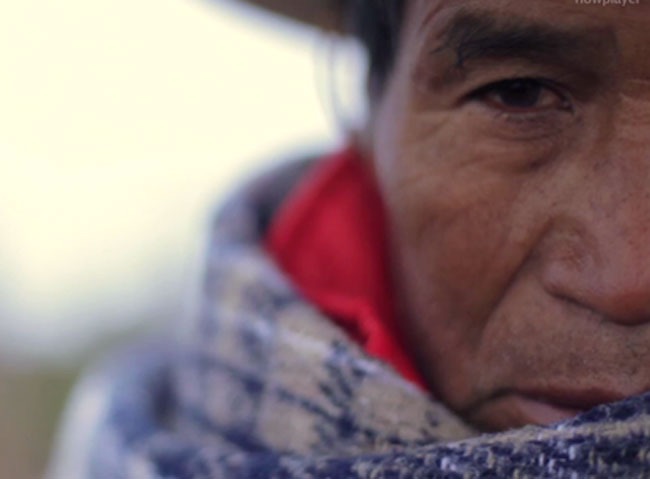Eco de la montaña
-
Réalisé par Nicolás Echevarría • Écrit par Nicolás Echevarría
-
Mexique • 2014 • 92 minutes • Couleur
- Réalisation :
Nicolás Echevarría - Écriture :
Nicolás Echevarría - Image :
Nicolás Echevarría, Sebastián Hofmann - Son :
Rodrigo de Vega Benavides - Montage :
Omar Guzmán
- N° ISAN :
non renseigné
Résumé
Pèlerinage à Wirikuta avec l’artiste mexicain Santos de la Torre, qui vient demander aux dieux la permission de réaliser une nouvelle œuvre, une mosaïque de perles figurant la cosmogonie Huichol. Le prologue, une archive de 1997, a un goût amer : on y voit l’œuvre murale du Mexicain Santos de la Torre inaugurée en grande pompe à la station Palais-Royal à Paris, quelques mètres au-dessus du Louvre. Mais "ils ne m’ont pas invité. Je suis allé faire ma récolte. Ils l’ont mal installée…". Juste retour des choses, c’est dans l’intimité domestique de Santos que commence vraiment le film. Pas seulement pour inscrire l’homme dans son environnement d’origine, mais pour comprendre que chacun de ses motifs perlés correspond à une figure historique, mythologique ou religieuse, dans une cosmogonie qui irrigue le quotidien. Du musée de Zacateca au pèlerinage à Wirikuta que Santos effectue pour demander aux dieux la permission de réaliser une nouvelle œuvre, le film épouse la forme de cet art méconnu. Procédant par tuilage, il fait l’aller-retour entre une image en train d’être composée et un imaginaire en train d’être vécu. Les scènes rituelles sur la Route de Peyotl reviennent comme des tableaux vivants, échos à la cartographie perlée de Santos. Au croisement de l’art et de l’ethnographie, Echevarria restitue à la fois l’amplitude du rapport huichol à la nature et au rêve, et l’humilité touchante de la technique de Santos : pour faire, en un an, la mer et le ciel, il faut une règle, un rouleau de scotch, des crayons de couleur. Et tout commence sur une feuille quadrillée. (Charlotte Garson)
A pilgrimage to Wirikuta with the Mexican artist Santos de la Torre, who comes to ask the gods for permission to create a new work of art, a mural mosaic showing the Huichol cosmogony.
The prologue, footage from 1997, has a bitter taste: we see the mural by the Mexican Santos de la Torre inaugurated in grand style at the Paris Palais-Royal metro station, a few metres below the Louvre. But "I was not invited. I went harvesting. It was badly installed…"In a fitting reversal, it is in the intimacy of Santos’ home that the film really begins. Not only to situate the man in his original environment, but also to understand that each of his beaded motifs corresponds to a historical, mythical or religious figure, in a cosmogony that irrigates everyday life. From the Zacateca museum to Santos’ pilgrimage to Wirikuta to ask the gods for permission to undertake a new work of art, the film espouses the form of this little-known art. Working its own beading, the editing fluctuates between an image being created and imagination coming to life. The ritual scenes on Peyote Road return like living tableaux, echoing Santos’ beaded cartography. At the intersection between art and ethnography, Echevarría recreates not only the breadth of the Huichols’ relationship with nature and dreams but also the moving humility of Santos’ technique: to create the sea and the sky in one year, you need a ruler, a roll of sticky tape, some coloured pencils. And everything begins on a sheet of chart paper. (Charlotte Garson)
Mot(s)-clé(s) thématique(s)
Sélections et distinctions
- 2014 • Festival International du Film d'Amiens • Amiens (France) • Sélection
- 2014 • Abu Dhabi – International Environmental Film Festival • Abu Dhabi (Émirats arabes unis) • Sélection
- 2014 • Arte Careyes • Mexico (Mexique) • Sélection
- 2014 • FICG (Festival Internacional de Cine en Guadalajara) • Guadalajara (Mexique) • Sélection
- 2014 • Cinéma du réel • Paris (France) • Compétition Internationale
Comment avoir accès au film ?
-
Édition DVD
- Il n'existe pas d'édition DVD à notre connaissance
-
Accès VOD
- Il n'existe pas d'accès en VOD à notre connaissance
- Distribution
- Aide sur les moyens d'accéder à un film
